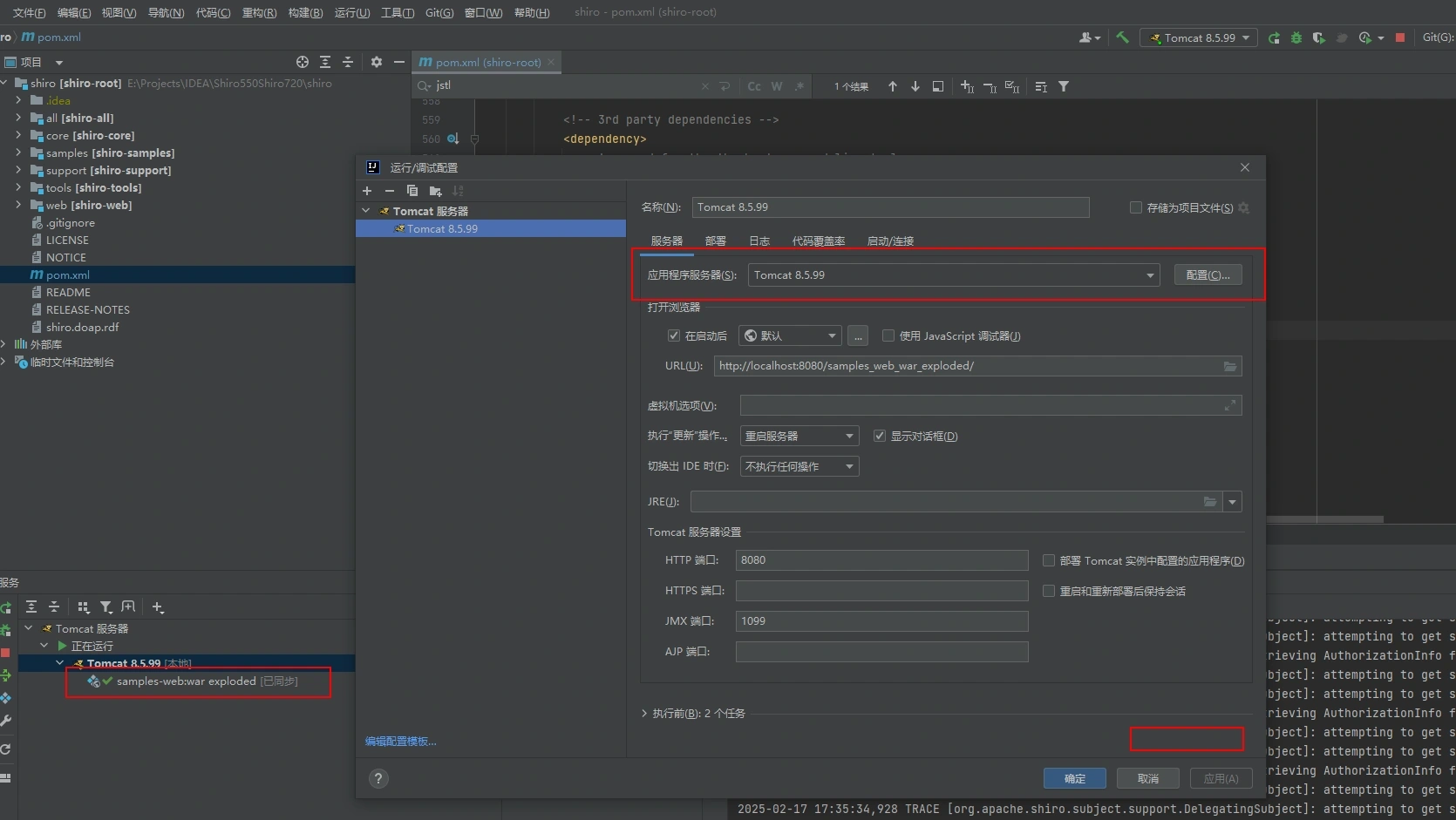Shiro550和Shiro721详解

AI-摘要
GPT-4.0-turbo GPT
AI初始化中...
介绍自己 🙈
生成本文简介 👋
推荐相关文章 📖
前往主页 🏠
前往爱发电购买
Shiro550和Shiro721详解
Takake1.shiro550
1.1.环境搭建
- getcode
1 | git clone https://github.com/apache/shiro.git |
- 编辑父项目pom文件,将jstl版本修改为1.2
1 | <dependency> |
- 配置tomcat
- tomcat历史版本下载地址:http://archive.apache.org/dist/tomcat/
- 修复工件,部署samples-web:war exploded,exploded表示默认展开的war包,多数用于开发测试环境。
1.2.测试
1.2.1.流量包登录特征
- 无论是否点击“记住我”选项,响应头的Set-Cookie字段中均存在remember字段。
1.2.2.代码跟踪&逻辑分析
- 首先根据文件名我们定位到CookieRememberMeManager.java的getRememberedSerializedIdentity方法。根据名字我们可以判断,这个方法就是用来获取我们请求Cookie中的rememberMe字段的。
- 通过断点调试我们发现,该方法是将request中cookie字段中的remeberMe字段进行BASE64解码之后返回二进制数组。
- 获取到该二进制数组之后转换为用户凭证,我们再更进convertBytesToPrincipals看一下具体是如何转换的。
- 我们看到,拿到该二进制数组之后进行了一次解密操作。
- 解密操作是在cipherService.decrypt方法中完成,在看该方法之前我们看一下getDecryptionCipherKey这个方法,这个方法应该是获取密钥的,我们看他的密钥是具体如何获取的。
- 密钥是如何获取的。
- 根据以上代码逻辑,我们可以看到密钥是硬编码的一段base64数据。kPH+bIxk5D2deZiIxcaaaA==
- 知道密钥了,那么再回到cipherService.decrypt方法,根据代码逻辑,我们可以看出,系统将字节数组的前128位,作为了iv偏移量。同时再将字节数组的前128位删除。
- 之后我们再进入下一个decrypt方法。
- 一直往下跟踪,我们可以看到使用的是AES算法,因此我们知道了密钥如何来的,解密用的什么算法,因此我们没必要再继续往下了。
- 我们返回跳出,看解密完成后,还会进行什么操作。我们一步一步跳出,最后回到最开始的decrypt方法。
- 跳出到PrincipalCollection方法我们发现,系统将解密的数据使用deserialize方法进行反序列化。
- 最后通过反序列化器进行反序列话,那么后面的代码就没什么好说的了,都是反序列化代码逻辑。
1.3.攻击流程
1.3.1.打CC链尝试
- 由于shiro用的是自己写的类加载器,其中使用了ClassLoader.loaderClass,是appclassloader不能加载数组类。(Lorg.apache.commons.collection.Transformer + .class找不到)(Class.forName是可以加载数组类的,主要的原因是因为tomcat)
抓取请求包,在cookie中添加字段base64(iv+AES(key,iv,serializedata))
首先我们需要尝试不进行使用数组类的情况下去,去构造CCv3的链,一般打shiro通常会打CC2,但是CC2需要CCV4,需要使用的V4中的TransformingComparator,因此我打算打CCv3版本自己构造的链逻辑如下。
- 代码逻辑如下
- 这样编写就只依赖需要CCv3版本了,中间没有数组类的加载。
1 | import com.sun.org.apache.xalan.internal.xsltc.trax.TemplatesImpl; |
执行后获取到ser.bin文件
在启动的shiro项目中加上cc依赖
1 | <dependency> |
- 然后将ser.bin使用aes加密算法进行加密,密钥为刚刚在代码中获取到的硬编码密钥。
- iv就随机的128bit的数就行
- 然后将加密后的数据前加上随机生成的iv,然后base64编码
- 发送payload
- 最后成功代码执行。
1.3.2.如何裸打CB链
- 在ysoserial中cb链和原生的shirocb版本不匹配序列化id有变化,因此打不通。
- 于是自己写了一条
- 代码逻辑如下
1 |
|
- 大家可能看到这里使用了CCv4版本,其实这个不碍事,只是在本地为了序列化而使用,实际并不会写入反序列化链中。因此即使shiro没有依赖CCV4,同样可以打。
2.Shiro721
Shiro721 漏洞详解(CVE-2019-12422)
CVSS V3 评分
- 评分:8.1(High)
- 向量:
AV:N/AC:H/PR:N/UI:N/S:U/C:H/I:H/A:H- 攻击复杂度(AC:H ):需利用 Padding Oracle 攻击,步骤复杂。
- 影响:可能导致远程代码执行(RCE)。
漏洞利用条件
- 影响版本: Apache Shiro < 1.4.2。
- 功能依赖:启用 RememberMe 功能(默认开启)。
- 密钥要求:服务端需使用固定密钥(默认密钥或已知密钥),但漏洞核心是 Padding Oracle 攻击,无需直接获取密钥。
- 攻击前提:
- 攻击者需获取一个有效的 RememberMe Cookie(作为已知密文)。
- 服务端需存在 Padding Oracle(响应差异暴露填充有效性)。
漏洞原理
- 加密模式缺陷:Shiro 使用 AES-CBC 模式加密 RememberMe Cookie,但未正确处理填充错误,导致攻击者可通过 Padding Oracle 攻击构造恶意密文。
- 反序列化利用:通过构造的密文注入恶意 Java 反序列化数据,触发 RCE。
漏洞复现步骤
- 获取合法 Cookie:
- 用户登录后,获取其 RememberMe Cookie(如通过窃取或诱导登录)。
- 检测 Padding Oracle:
- 修改 Cookie 的末尾字节,观察服务端返回差异(如 500 错误与正常响应的区别)。
- 生成恶意 Payload:
- 使用工具(如
ysoserial)生成反序列化 Payload(如 CommonsBeanutils1 链)。 - 通过 Padding Oracle 攻击(如
padBuster或专用 PoC 工具)加密 Payload,生成合法密文。 - 密钥填充原理:https://blog.csdn.net/qq_41874930/article/details/121314926
- 使用工具(如
- 发送恶意请求:
- 将构造的恶意 Cookie 发送至目标,触发反序列化漏洞。
示例工具命令:
1 | # 使用 ysoserial 生成 Payload |
影响版本
- 受影响版本:Apache Shiro 1.0.0 至 1.4.1。
- 修复版本:Apache Shiro ≥ 1.4.2(改用 AES-GCM 加密模式,禁用 CBC 模式)。
防御建议
- 升级到 Shiro ≥ 1.4.2。
- 更换默认密钥(但仅升级才能彻底修复)。
- 禁用 RememberMe 功能(若无需使用)。
与 Shiro550 的区别
Shiro550(CVE-2016-4437):
- 利用硬编码密钥加密,无需 Padding Oracle。
- CVSS 9.8(Critical),利用更简单。
Shiro721(CVE-2019-12422):
需要可信的用户凭证。
依赖 Padding Oracle 攻击,需已知密文。
攻击复杂度更高,评分 8.1(High)。
通过理解加密模式缺陷和反序列化利用链,可深入防御此类漏洞。建议结合流量监控和 WAF 规则拦截异常 RememberMe Cookie。
评论
匿名评论隐私政策
✅ 你无需删除空行,直接评论以获取最佳展示效果


































